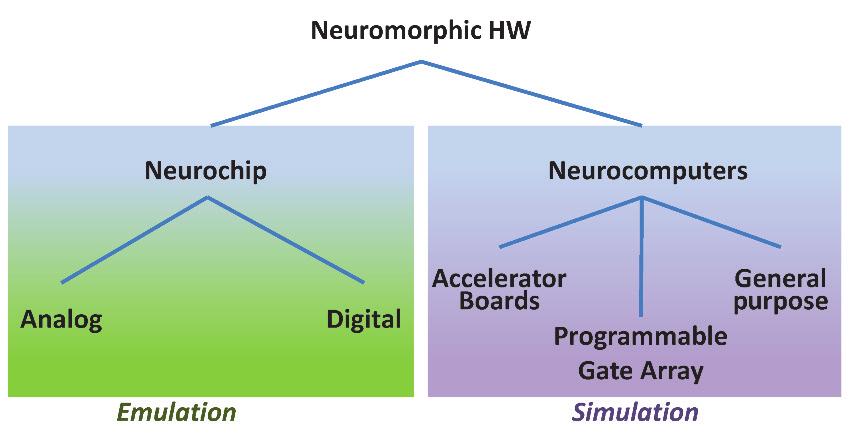Sections
Neuromorphic chips are electronic systems that mimic the function of human brain or parts of it. These neuromorphic chips have attracted the attention of many and are deployed in various applications in the fields of computation and medical science. A good example is the use of neuromorphic chips in retinal implant technology which is being developed to help people who have lost their vision gain partial vision. These chips proving to be useful in several applications are a type of neuromorphic hardware.
Neuromorphic hardwares are links between human brain and electronic circuits. This link can be from hardware to brain or vice versa. The former is the conventional approach which is still widely accepted and used. Using this approach scientists try to develop electronic systems capable of performing the functions of human brain. Neruromorphic chips are developed using this approach. The latter is development of new architectures for computing inspired from the biological structure of neurons. Hardware implemented using this approach are called neurocomputers.
Neuromorphic Computing was introduced by Carver Mead in the late 1980s. He and Lynn Conway are regarded to be the initiators of revolutionary changes not only in the field of electronics but every aspect of academic education called the Mead & Conway revolution. This was possible because of their breakthroughs in the field of Very Large Scale Integration (VLSI). Carver Mead used analog VLSI circuits to develop analog neurochips and laid foundation to the field of neuromorphic computing. Since then this field has evolved so much that many diverse methodologies are being adopted. These are broadly classified into emulative and simulative strategies. Neurochips a developed using emulative strategies while neurocomputers are developed by employing simulative strategies.
Neuromorphic chips are implemented using micro- and nano-scale transistors. Non-linearity of silicon transistors makes replicating the electrochemical functions of human neurons easier. In neuromorphic chips transistors conventionally used as switches are also used as analog dials. They are also very useful in providing neuroplasticity to the neuromorphic chips, a characteristic of human brain that enables it to modify synapses during processing of data.

Conventional neuromorphic chips are implemented using analog electronic circuits because they are very close to biological neural networks both in function and energy consumption. Having these advantages though, these chips are not devoid of the disadvantages of analog circuits. A digital neuromorphic chip overcomes them by offering faster and more reliable computing and easier implementation but not without having much larger sizes of circuits. Mixed models employing both analog and digital VLSI are also in use. An example is the "Spikey" chip developed under the FACETS project.
Under FACETS (Fast Analog Computing with Emergent Transient States) project that started in 2006 and concluded in 2010 was carried out researches on various domains that contributed heavily to neuromorphic computing. Spikey Chip implemented as a part of it is a network of circuits that emulates a network of neurons and synapses and follows the leaky integrate and fire model (LIF). The use of analog circuits instead of digital circuits lets proper emulation of synapses because the strength of neural connections are varying which cannot be mimicked using them.
Spiikey is a single chip system. FACETS project also involved development of Wafer Scale Integration systems. Wafer Scale Integration is a technology in which connections among chips are established directly in the wafers providing more number of connections in a given area. The FACETS wafer integration system is implemented from HICANN (High Input Count Analog Neural Network) chips. The HICANN chips are interconnected among themselves and switches are provided at each interconnection. The HICANN chip consists primarily of a network of several neurons and synapses called Analog Neural Network Core (ANNCORE). The synapses in the ANNCORE gain access to the signals running through the interconnections using additional switching elements.
The contributions of FACETS project is used in the Human Brain Project (HBP) to implement its neuromorphic computing systems. While NM-PM is a neurochips-like computing system HBP also has a neurocomputers-like computing system. Like the FACETS systems NM-PM also employs both analog and digital circuits. The NM-PM computing system is not governed by any program but by the variations in the properties of the components. Another contribution from FACETS to HBP is PyNN.
FACETS project involved the use of several software simulators and hardware emulations to model the neural networks. This led to the development of a cross platform language, PyNN for unifying all the experiments done on these simulators and emulations. Programs are written on Python using the PyNN API and run on the various simulators without modification. Python is very flexible and suitable for writing easily understandable codes and thus preferred by FACETS. Although the FACETS project concluded PyNN is being made available and maintained by Neural Ensemble, a community driven initiative. PyNN will be used throughout the long term Human Brain Project.
A medical application of neuromorphic chip was mentioned in the beginning itself. The application of these chips is not limited to any domain but extends through diverse fields.
Neuromorphic chips attract the attention of companies in the field of computation because they are far more efficient in terms of energy consumed. An example is SyNAPSE (Systems of Neuromorphic Adaptive Plastic Scalable Electronics) project that aims at developing extremely low power computational systems like the biological systems. Recently, IBM a part of SyNAPSE project tested a chip, TrueNorth. An advantage of these neuromorphic chips is that they store information as synaptic strength the systems developed from these chips does not need separate computational and memory units. Another advantage of using neuromorphic chips in computational systems is their durability.
Neuromorphic chips are also finding applications in space research. NASA is funding research on Neuromorphic Systems & Artificial Neural Membrane (ANM) Technology to develop the Flapping Wing Concept Vehicle. Neuromorphic chips can help in understanding human brain also.
Sections